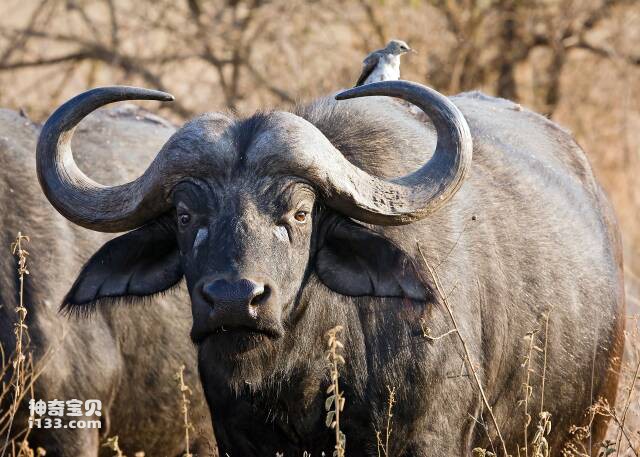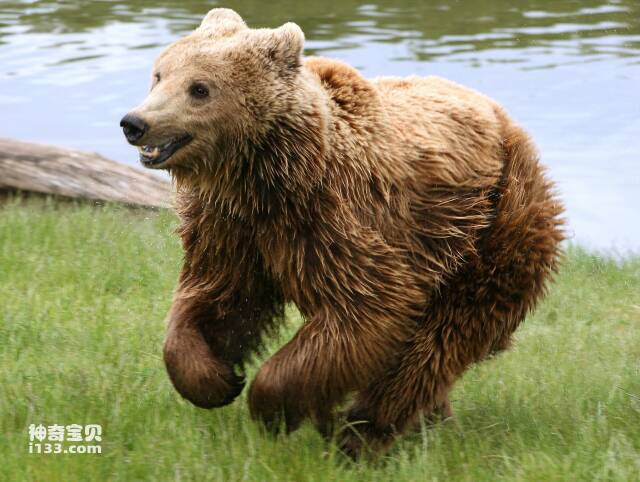The aggressiveness of animals refers to the aggressiveness and deterrence they display in hunting, defense or competition. Nature is a place where the weak eat the strong. Only animals with strong attack power can stand at the top of the food chain and become the overlord. So do you know which animals in the world have the strongest attack power? This article brings you the top ten most aggressive animals in the world. How many do you know? The top ten most aggressive animals in the world are killer whales, tiger sharks, Elephants-Are-Endangered.html">elephants, African wild buffalo, lions, tigers, crocodiles, brown bears, cassowaries, and chimpanzees. Let’s take a look.

1. Killer whale (Orcinus orca)
Killer whales, also called killer whales, are marine mammals that live in all oceans around the world. They are also the largest known dolphin species. Killer whales are 9-10 meters long, weigh 6-8 tons, have a large head, towering dorsal fin, and usually have black and white skin. Killer whales are apex predators that feed on fish, squid, seals and other marine life. They are ferocious in nature, have extremely strong attack power and intelligence, and are considered one of the most dangerous predators in the ocean. Killer whales have a very developed social structure and cooperative abilities. They often hunt in small groups and cooperate with each other to hunt food. Killer whales are widely distributed in many waters around the world, including the Arctic, Antarctic, North Pacific, South Pacific, North Atlantic and South Atlantic. They are highly mobile animals that can swim almost anywhere. Killer whales have also been endowed with many mysterious symbolic meanings, representing courage, strength and wisdom in legends.

2. Tiger shark (Galeocerdo cuvier)
The tiger shark is a large shark that lives in tropical and subtropical oceans around the world and is one of the most dangerous sharks known. Tiger sharks can reach more than 6 meters in length and weigh about 700 to 900 kilograms. Their backs are dark blue or gray with obvious black stripes, and they are called "tiger" sharks. Tiger sharks feed on a variety of fish, turtles, birds and mammals. They actively search for prey when wandering in the ocean, and often appear in shallow waters and near coastlines. Tiger sharks have extremely strong attack power and speed. They generally use surprise attacks and can often kill their prey in one go. Tiger sharks are a very dangerous fish, and according to statistics, they cause many human casualties every year. Therefore, the tiger shark is also listed as an endangered species and has received global attention, and conservation measures must be adopted to ensure the survival of the species.

3. Elephant
Elephants are the largest land animals in the world and belong to the family Elephantidae. They are characterized by their large size, long nose, big ears, and huge teeth. They can reach a height of 3-4 meters and a weight of more than 7 tons. Elephants are highly intelligent animals with excellent memory, emotional and social abilities. Their intelligence is comparable to that of primates, they can use tools to obtain food in the wild, and they have a high level of emotional expression, such as expressing condolences to deceased members of the group. Elephants are generally gentle and friendly animals, but in certain situations they may display aggression to protect themselves or their territory. The elephant's trunk is very flexible and can be used to slap and hit enemies. In addition, elephant teeth are very sharp and can also be used for offense. The elephant's feet are extremely strong and can crush or kick an enemy to death. Because elephants' tusks are so hard, they sometimes use them to sting enemies or other threats.
Although elephants do not often attack humans, they can become very dangerous when they feel threatened or provoked. Therefore, the protection and respect of wild elephants is very important. We should avoid conflicts with elephants and stay away from these animals as much as possible to ensure the safety of humans and elephants.

4. African wild buffalo (Syncerus caffer)
The African wild buffalo is a giant herbivorous mammal that lives on the African continent, also known as the "black buffalo". They are very strong animals, much larger than the average domestic cow. The body length of the African wild buffalo can reach 3 to 4 meters, the shoulder height is about 1.5 meters, and the weight can reach more than 900 kilograms. African wild buffalo have a very developed body structure and aggressiveness. They have a pair of sharp and powerful horns that can be used to defend their territory or defend themselves against enemies. In addition, they have strong bodies and muscles and are extremely brave. Even in the face of very dangerous predators, they can fight back resolutely. The African wild buffalo is a very spectacular and majestic animal and a very important ecological component on the African continent. We should take practical and effective measures to protect these animals to ensure that they can continue to exist and thrive in their natural environment.

5. Lion (Panthera leo)
The lion is a large cat that lives in Africa and the Indian subcontinent. It is one of the largest existing cats. Males can weigh 190-240 kilograms as adults and are about 3.5 meters long. Females are slightly smaller. Lions usually live on the savannah and are ferocious by nature. They feed on large mammals, such as cattle, antelopes, zebras, etc. Their hunting method usually relies on speed, strength and excellent hunting skills to obtain food. Lions are social animals and often form family groups, with males as the leaders, who work together to find food and protect their territory. Lions are very good hunters, with well-developed teeth and claws. They pounce on their targets with amazing speed and power, often killing them with one blow. In addition, lions are also regarded by humans as animals that symbolize courage and strength and have a special status in culture. The lion is a very spectacular and mysterious animal with extremely high scientific and cultural value. We should strengthen the protection and management of their habitats, avoid overhunting and habitat destruction, and strive to ensure that they can continue to be their species in the future.

6. Tiger (Panthera tigris)
The tiger is a large cat that lives in Asia and is one of the most iconic wild animals in the world. Tigers are very large, with a body length of up to about 3.5 meters, a shoulder height of more than 1.2 meters, and a weight of 300-600 kilograms. Tigers are carnivorous animals that feed on wild mammals, such as deer, wild boars, goats, etc. They also prey on domestic animals and humans. They are usually nocturnal and can jump over 3-meter-high obstacles in pursuit of prey. Tigers are solitary animals, each with its own territory and unique personality. Tigers are an extremely endangered animal. It is estimated that there are only about 3,900 tigers left in the world, most of which live in India and Southeast Asia. Although tigers are considered a threat to humans, they have high scientific and cultural value. We should strengthen the protection and management of tiger habitats, avoid overhunting and habitat destruction, and strive to ensure that they can continue to maintain their species in the future and enable humans and tigers to coexist peacefully.

7. Crocodilia
Crocodiles are a type of reptiles that live in freshwater and oceans, including crocodiles, alligators, snapping turtles and many other different species. They are large, have tough skin, can dive for long periods of time, and are carnivorous. They like to swim, hunt and rest in the water. They can dive for hours or even days without breathing air, and they have good visual and auditory perception capabilities. Due to the competition and oppression in the crocodile's living environment, they gradually developed strong offensive and defensive abilities. The crocodile's mouth is so powerful that it can easily break bones and pull its prey back into the water to drown. In addition, the crocodile's skin is thick and tough, which can effectively protect itself from attacks. Crocodiles are very special and mysterious animals and play an important role in the entire ecosystem. We should do our best to protect crocodiles and their habitats and comply with relevant laws and regulations to ensure their continued survival into the future.

8. Brown bear (Ursus arctos)
Brown bears are large mammals that live in North America, Eurasia, and Asia. They usually eat plants as their main diet, but they also eat small animals and fish. Brown bears are huge, with adult males weighing more than 450 kilograms and reaching a shoulder height of about 2.5 meters. Brown bears are solitary animals that like to build their dens in relatively secluded places such as woods and mountains to hide from humans and other threats. They have a strong sense of smell and hearing and are very intelligent and sensitive. Although brown bears do not usually attack humans, they can become very dangerous when they feel threatened. The brown bear is a spectacular and mysterious animal with an important ecological role. We should strengthen the protection and management of their habitats, avoid overhunting and habitat destruction, and strive to ensure that they can continue to continue their species in the future and coexist peacefully with humans.

9. Cassowary
The cassowary, also known as the cassowary, is the most aggressive of the birds. It is tall and has a protective horny helmet on its head. You can hit the grass while walking through the forest. Their wings degenerate earlier than those of ostriches and rheas, making them unable to fly. The head is blue, with one or two red dewlaps on the throat, black plumage, long legs, strong and powerful, and sharp claws. 3 toes, the inner toe has a long and sharp claw for defense. This bird has a unique trick to fend off enemies. Once it encounters an enemy, it leaps into the air with a roar, then aims at the target and strikes hard with its powerful legs. The long claws on its toes are like sharp swords. Stab into the opponent, causing the opponent to be injured in a minor case or killed in a serious case. Cassowaries live in tropical rainforest areas, in pairs or alone. Good at running and jumping, alert, ferocious, and highly aggressive. The sound is as thick as thunder. It can run, is good at jumping, and often uses its sharp inner toe claws to attack natural enemies. Feeds on seeds and berries. Cassowaries are considered the most dangerous animals in zoos.

10. Chimpanzee (Pan troglodytes)
In addition to strength, attack power is also one of the important manifestations of combat power. Chimpanzees are the most intelligent animals known after humans. Chimpanzees usually live in tropical rainforests or mountain forests and live in family groups. Each family group usually consists of dozens of adult chimpanzees and has a clear social hierarchy and role division. Chimpanzees are highly intelligent and can use a variety of tools, learn languages, and solve simple calculation problems. They also display advanced cognitive abilities such as emotional resonance and self-awareness. We should strengthen the protection and management of their habitats, avoid over-exploitation and habitat destruction, and strive to ensure that they can continue to continue their species in the future and coexist peacefully with humans.
In short, the aggressiveness of animals is an important characteristic they display in their survival and competition, helping them survive in the natural environment. We should strengthen the protection and management of their ecological environment, avoid over-hunting and reduce the impact of human activities on their habitats.
animal tags:
We created this article in conjunction with AI technology, then made sure it was fact-checked and edited by a Animals Top editor.